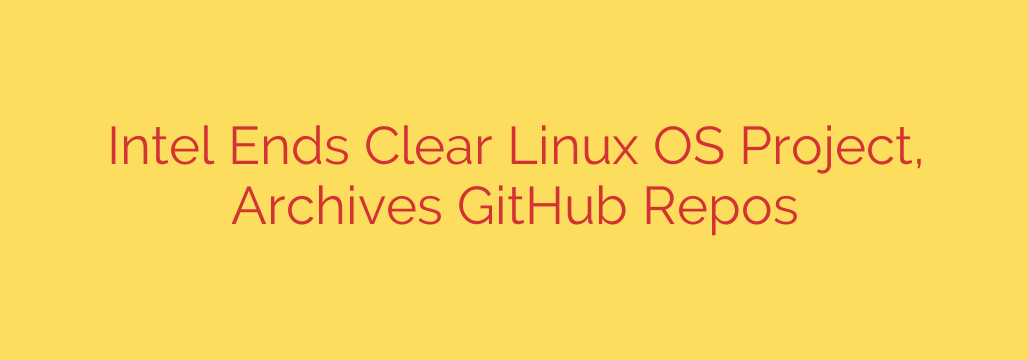
The End of an Era: Intel Sunsets Its High-Performance Clear Linux OS
In a significant move for the open-source community, Intel has officially discontinued its innovative Clear Linux OS project. Once hailed as a trailblazer for performance and security, the Linux distribution known for its extreme optimization for Intel hardware is now being wound down, marking the end of a unique chapter in the Linux landscape.
For developers, system administrators, and performance enthusiasts who built their workflows around Clear Linux, this news requires immediate attention. The project’s official GitHub repositories have been archived, effectively freezing development and signaling a hard stop for all future updates.
What This Means for Clear Linux Users
The discontinuation of an operating system is a serious event that goes beyond simply halting new feature development. The most critical consequences are:
- No More Updates: All software package updates, bug fixes, and performance enhancements have ceased. The
swupdcommand, Clear Linux’s package manager, will no longer receive new bundles. - A Halt to Security Patches: This is the most severe implication. Continuing to run Clear Linux will expose your systems to unpatched, high-risk security vulnerabilities. As new threats are discovered, your installation will remain unprotected, making it an easy target for attackers.
- Repositories Are Now Read-Only: The project’s source code and package repositories have been archived. While they remain accessible for reference, no new contributions or changes will be accepted. The project is effectively a museum piece.
For anyone running Clear Linux in a development, production, or even personal capacity, the message is clear: it is no longer safe to use, and you must plan a migration to a new operating system immediately.
What Made Clear Linux Stand Out?
Clear Linux wasn’t just another Linux distribution. It was an opinionated, highly-engineered OS built from the ground up by Intel to showcase the full potential of its own hardware. Its reputation was built on several key pillars:
- Aggressive Performance Optimization: Clear Linux was famous for its speed. It used aggressive compiler flags and system defaults specifically tuned to squeeze every last drop of performance from Intel CPUs. For many benchmarks, it consistently out-performed other popular distributions.
- Stateless Philosophy: The OS was designed with a “stateless” approach, strictly separating the core system files from user configuration and data. This made system management cleaner and updates more reliable.
- Proactive Security: From its default settings to its kernel configuration, Clear Linux was built with a security-first mindset, aiming to provide a hardened environment out of the box.
- Efficient Software Management: Its unique
swupdpackage manager focused on delivering updates in functional bundles rather than individual packages, which made the system fast and easy to keep current.
Actionable Advice: Migrating Away from Clear Linux
With the project’s end, the most important task for users is to find a suitable alternative. The best choice will depend on your original reason for using Clear Linux. Here are some excellent, actively maintained options:
For Cutting-Edge Performance & Desktops:
- Fedora Workstation: Known for its close relationship with upstream projects, Fedora offers a modern, polished experience with up-to-date software. It provides a great balance of usability and advanced features.
- Arch Linux: For users who love customization and a rolling-release model, Arch provides a minimal base and the freedom to build a system precisely to your specifications.
For Stable Server & Cloud Deployments:
- Debian Stable: A rock-solid choice renowned for its stability, vast package repository, and strong security team. It is a cornerstone of the Linux world for a reason.
- Ubuntu Server LTS: Backed by Canonical, Ubuntu’s Long-Term Support releases offer five years of security updates, making it a reliable and popular choice for production servers.
- Rocky Linux or AlmaLinux: If you need an enterprise-grade, RHEL-compatible operating system, both Rocky and AlmaLinux are excellent, community-driven replacements for the old CentOS Linux.
While the end of Clear Linux may be disappointing for its user base, the open-source ecosystem is resilient. The project’s innovations have undoubtedly influenced other distributions, and its legacy of pushing the boundaries of performance will not be forgotten.
For now, the priority is clear. If you are a Clear Linux user, the time to migrate has arrived. Begin evaluating alternatives and plan your transition to a fully supported and secure operating system to protect your data and infrastructure.
Source: https://www.bleepingcomputer.com/news/security/intel-announces-end-of-clear-linux-os-project-archives-github-repos/








